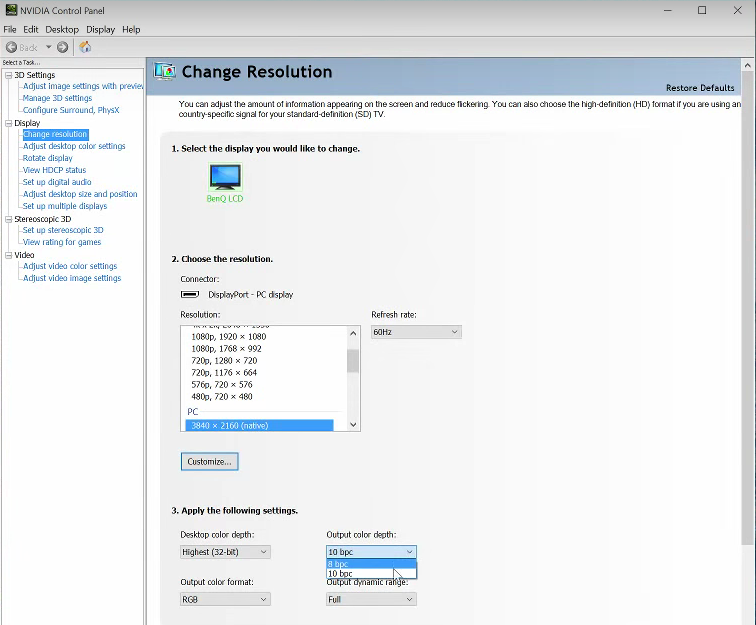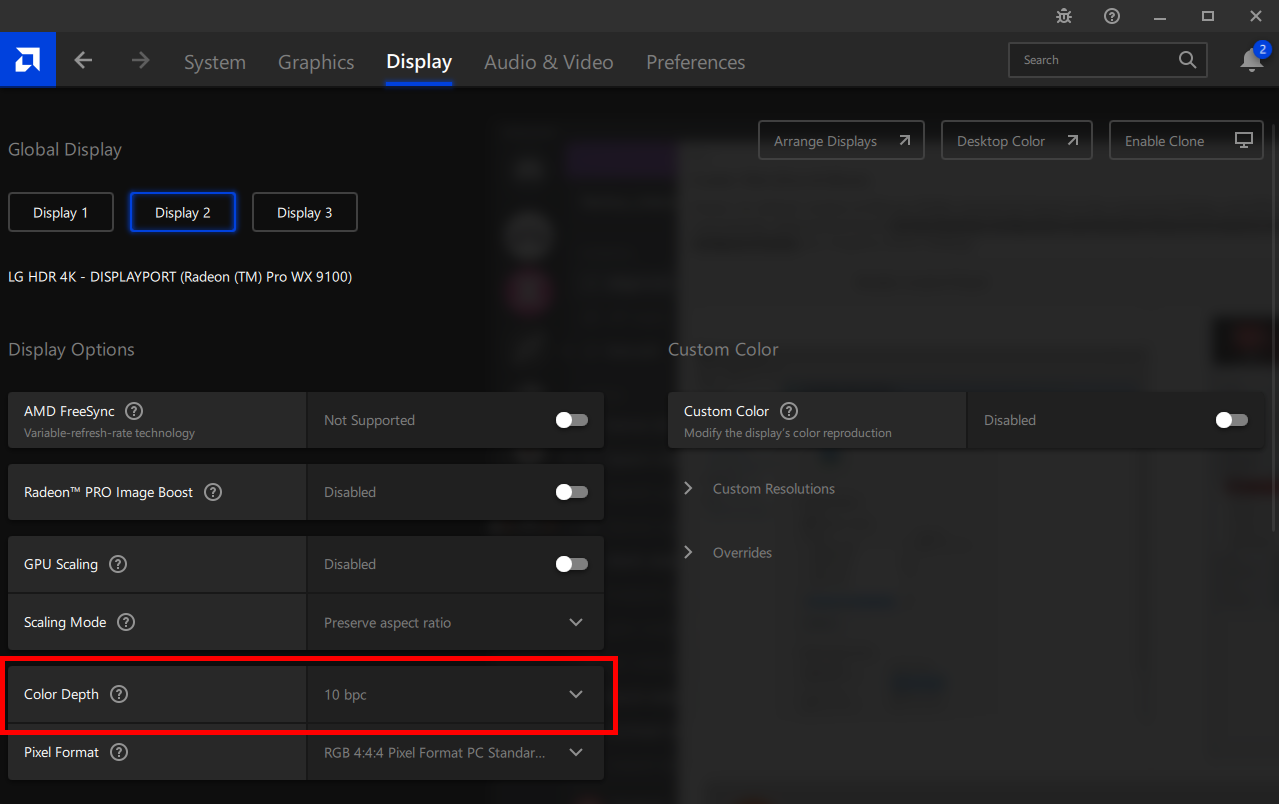Device Configuration
Table of Contents
General
The following pages describe the settings for the Input and Output devices. For more general information about the Video Engine, Stream Modes and Render Pipes, please see here.
The Device Configuration contains the settings for video input and output devices, touch, audio and tracking devices. Different configurations can be activated and edited in the overview window. The Device Configuration file extension is .vdev.
Since Ventuz 7 it is possible to change the Device and Machine Configurations while the runtime is running. Changes are applied immediately with saving an active configuration.
Clicking Save saves any changes that have been made. While editing the currently active Device Configuration, changes are immediately applied to the Engine.
Clicking the Revert icon, the last change is undone.
Clicking Close, the editor is closed and set back to the overview of available Device Configurations. The Device Configuration Editor consists of multiple window tabs for the different categories of devices and settings.
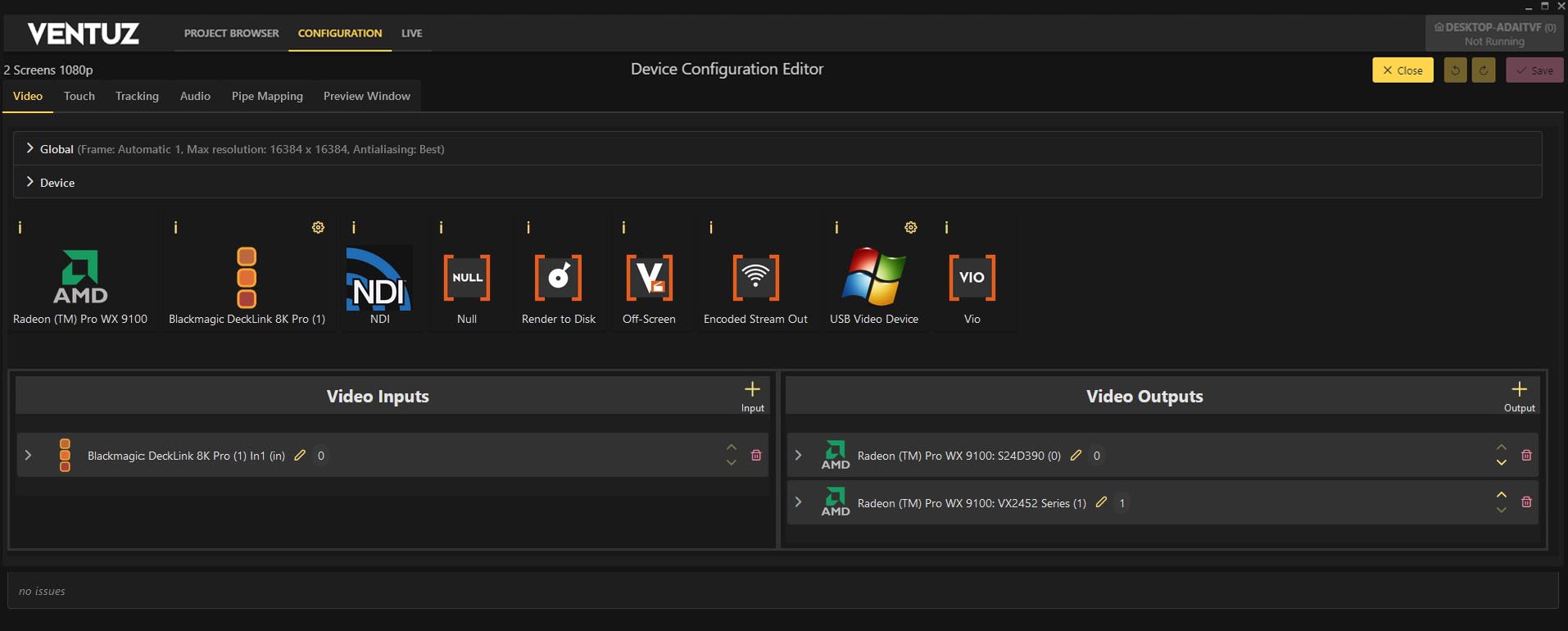
Video
In the Video section all settings are made for video input and output devices. Settings marked with (Live Option) can be edited during running runtime in the linked Live Options.
Global
The Global settings are set for all devices across the machine.
| Setting | Description |
|---|---|
| Global Frame Rate | Set the global frame rate for the machine. If set to Automatic the output device defines the global frame rate. All outputs must use the same frame rate. It is not possible to render in mixed frame rates from one machine. If set to specified frame rate, Ventuz will try to set the output to this frame rate. GPU out modes can change the output frame rate of the physical to the selected one. The Global Frame Rate is used to calculate many processes inside of Ventuz, such as the Mover Node regardless of this setting. This is still true if the connected display cannot support the set frame rate. |
| Frame Multiplier | Increases the steps of the Cluster Clock by the multiplier factor. This is necessary for a mixed frame rate scenario in a Cluster. |
| Max Resolution | The maximum resolution the Ventuz engine will scale up to while rendering. |
| Antialiasing | Sets globally the Multisample Anti-Aliasing (MSAA). Best (default): Selects the highest available level of multisampling quality depending on the output device. Medium: Selects the mid range (Best/2) of available quality levels. Low: Selects low quality level. None: Disables Antialiasing. |
| Border Color | Default background color of a Screen when no Content is mapped on or the Content is blended with additive blending. |
| Show Mouse Curser | Enables the visibility of the mouse curser in the outputs. |
| Effect Bleed | (Live Option) The Effect Bleed adds an extra margin around the rendered content. The value is the percentage of the output height, which will be added to all sides. It will not extend the visible/physical output, but will allow layer effects to create better results close to the output border or across machine borders in Cluster Setups. |
The DirectX limit for the maximum resolution is fixed to 16k by 16k pixel per machine
Setting up the Antialiasing in the Layer Root Node properties will overwrite the global Antialiasing setting!
Multisampling only affects the edges of geometries. It does not affect the quality of textures, texture based text or live video textures!
Select None multisampling for scenes consisting of texture and Text 2D based fonts only or if the displayed graphics is a 2D design. Multisampling will not improve the quality but will, instead, lower the rendering performance. Except when using the plain layer and High Quality 2D Text Rendering is disabled. Non-high-quality relies on multisampling.
Device
The Device settings are set for single devices. You can access these by clicking the cogwheel icon of a device or selecting a device in the dropdown menu on the right side in the Device section. The settings differs from device to device.
For more specific information of SDI boards, see here.
The following settings may be available:
| Setting | Description |
|---|---|
| Genlock Source | Select the source for the Genlock. Most SDI-boards support SDI-inputs and a special reference signal inputs. To disable genlock choose internal. |
| Genlock Format | Select the format of the genlock signal. Usually the genlock will lock on a signal much faster if it is not in Auto Detect mode. |
| Genlock H & V Offset | (Live Option) This allows to offset output streams from the genlock signal. When the Genlock Format is not known, some boards only allow vertical (pixel) offset and no negative offsets. If the format is known, Ventuz can automatically convert (possibly negative) H & V offsets into a positive vertical offset independent from the boards capabilities. |
| Watchdog Timeout | (Live Option) Set the hardware watchdog of the device. The value is in milliseconds. 0 disables the hardware watchdog. Do not confuse this device feature with the software watchdog. |
| Multi Channel | DVS boards can be switched between single and multi-channel modes. This usually happens automatically, but if there is some confusion, set it manually. |
| Video Norm Input X | Deltacast capture boards require manual specification of the kind of signal to expect. |
| Preserve EDID | This tells Deltacast capture boards to preserve a pre-programmed EDID (monitor id). This allows to use the Deltacast E-EDID tool to program an EDID into the board, and it will not be overwritten with a default EDID. |
| Verify Frame Rate | This is for Video for Windows inputs (like Webcams). When auto-detecting a signal, this verifies the frame rate. This is recommended, but disabling this may sometimes help locking on to input signals that are otherwise refused. |
| Auto-Detect 4k Modes | Some SDI boards receive 4k streams as quad-link HD or quad-link 3G streams. Unfortunately there is no standardized marker to distinguish a quad-link 4k streams from 4 normal streams. Normally, Ventuz will interpret a quad-link 4k stream as four independent streams. With this options Ventuz will assume that 4 identical streams will form a quad-link 4k stream if possible. Some streams can not form quad-link 4k, like interlaced or SD streams, these will still be handled as individual streams. |
| Color Sampling | for BlackMagic HDMI capture, specify if the input is YUV 4:2:2 or RGB 4:4:4. This is not required when using Autodetect. |
| Audio Capture Source | Specifies the audio input stream source. |
Following recent Microsoft Windows Updates to Full Screen Optimization, synchronization between frames across multiple GPU outputs may not be as predictable as before.
Enabling Mosaic Mode can solve this issue. In most cases, the timing discrepancies are minimal and unlikely to be noticeable to users. However, in scenarios where multiple displays are arranged with adjacent pixels, such as two touching LED walls using two outputs, such discrepancies may become more apparent. To ensure optimal synchronization in these situations, we recommend enabling Mosaic Mode. This only occurs when using multiple outputs on one GPU. If only one output is being used, this issue does not occur even if using multiple GPUs in one machine.
Video Input
Inputs can be dragged into the Inputs window or added by pressing on the Plus sign. There is only one input mode, but some output modes include input streams as well. When adding these streams to the input or output window, the correct stream is added automatically. The stream settings are mirrored on both sides.
These inputs can be used in Ventuz with the Live Video Node with the ordinal number of the stream.
| Setting | Description |
|---|---|
| Video Format | The input format can be configured independently from the video format of the outputs. For best results, the frame rate should be the same as the output and all signals should be genlocked together. Most video boards support Autodetect mode. If the video mode of an autodetect input switch, the video engine will synchronize on the new signal. If the video board is not in autodetect mode, it will report signal lost until the stream switches back to the configured video format. |
| Note: There are specific boards, e.g. Deltacast SDI boards, which do not support mixed framerate. See: SDI hardware information | |
| A list of available formats can be found here, but not all boards support all formats. | |
| Use on GPUs | Since Ventuz 7 and Multi GPU support, it is possible to select the availability of input streams on a certain GPU with the Use On GPUs setting. Which might be necessary for performance reasons. Per default, all input streams are usable on all GPUs. |
| Mipmaps | Input streams can automatically create mipmaps. Mipmaps are only useful if the incoming video is displayed either in 3D or smaller than 50% of its native resolution. |
For more video input settings, check the Advanced Video Options
Some devices may change their stream configuration, depending on the connected physical cabling. In such a case Ventuz will report a missing stream on start-up.
Video Output
Outputs can be dragged into the Outputs window or added by pressing on the Plus sign. Depending on the device, the output mode is a simple output rendering or a different Stream Modes. Depending on the device, select the port to use. For GPU outs the name of the connected display is shown or the port number for SDI devices.
The ID behind the stream name is especially important when setting up the Output Mapping in the Render Setup, since they match with the Output Number in the Mapping tab. With the Pencil Icon it is possible to edit the output to a different existing connector of the device. For example on a GPU out with multiple physical outputs, the used output is changeable without re-creating the whole stream with its settings. For GPU outs the (0) at the end of the output name shows the PCI-slot used for the card.
The number in brackets following the name of the GPU and display name, refers to the physical GPU itself. This number refers to the PCIE slot that the GPU occupies on the motherboard. It is not possible to change this number.
| Setting | Description |
|---|---|
| Pipe | Select the Pipe to be used for this output. With the Pipe Mapping it is possible to create multiple independent pipes. With this setting you can bind an output to a pipe. With Default the editor automatically maps the next pipe. With no configured pipes, all Outputs are mapped to the one default pipe. |
| Resolution | The resolution Ventuz is rendering on this output. Some Output Modes will disable this property. |
| Video Format | On SDI devices the output is configured as format. The list of available outputs depends on the hardware used. With a specified input stream, the configurable formats might change. For more information: here |
| Interlaced | Activate interlaced video on a specific output stream. (e.g NDI and Render To Disk) |
| Allow Scaling | With multiple outputs rendering the same content, (e.g. one Screen is mapped on a 2160p output and a 1080p GPU output) Allow Scaling will enable upscaling or downscaling the rendering, instead of rendering for each output independently and save performance. For more details see: here |
| Render On GPU | Select the rendering GPU for this device out. With a SDI output device you can specify the rendering GPU. Default will render on the GPU the output is connected to. |
| Output Mode | With the Output Mode the GPU display mode is set. In the Performance Statistics you can check if the selected Output Mode is set and applied correctly |
| Floating Window: Runtime opens a bordered window in the specified Resolution. The window is movable and resizable. The rendering will stay in the set resolution but might get scaled or filled up with the set Border Color in the background. | |
| Full Screen (Desktop Rate): The output is displayed in full screen at the desktop resolution and refresh-rate. The Resolution Property is not changeable and therefore greyed out. Windows Fullscreen Optimization is used, so there is no output mode change on runtime start and the performance is the same as Exclusive Fullscreen. If there is another application taking focus on the output screen, the rendering will stay in fullscreen on top. Be aware that Windows internal desktop features, (e.g. thumbnail of the Runtime in the Taskbar or highlighting a single application), might result in frame adjustments. Exclusive Fullscreen mode is not affected by this, since it is not using fullscreen optimization. | |
| Full Screen (exclusive): The output is set as a exclusive fullscreen. When starting Ventuz Runtime, the output is re-initialized and will flicker. With more monitors connected, it may take longer for Windows to initialize all of the outputs. In this mode there is no Windows Fullscreen Optimization active. The Resolution might be changed manually, and therefore the rendering is scaled up or down or the aspect ratio changes. The output will always use the full screen. Note: The selected resolution must be supported by the output device. Most screens only support specific formats of resolution and refresh rate. If there is another application that takes focus on the output screen, Runtime will be minimized. Be aware of background programs like malware detection. Ventuz is able to set the frame rate for exclusive fullscreen mode. If the Global Frame rate is specified, the output will be changed to that frame rate if the display device supports it. If a display does not support the specified frame rate, Ventuz will render in the output frequency. Note: Switching from Full Screen (Desktop Rate) to an exclusive fullscreen mode, may require restarting Runtime. With the Performance Statistics you can check if the output mode is set correctly. We recommend using Full Screen (Desktop Rate), since this mode works better with multiple outputs running synchronously | |
| Full Screen (Swap Sync): The same output mode as Full Screen (exclusive), but it behaves differently in a Cluster scenario with hardware synced GPUs on all machines. In such a scenario the Swap Sync mode will only play out a frame on all machines together. If there is a render stall on a single GPU, all GPUs will wait and the frames stay in sync. If there is no sync-board configured, this mode will automatically fallback to Exclusive Fullscreen. | |
| Render to Disk Name | File name of the output file, when rendering the output with Render to Disk |
| Touch Groups | With these settings you can override the touch settings in the Touch section of the Device Configuration for a specific output. It is possible to map the incoming touch of a GPU touch monitor to a different Touch Group than the other outputs. |
| Alpha Output | There are different modes for rendering the alpha and color channels with external keying for NDI and SDI |
| Straight: Non-Premultiplied, as most common image formats that allow for alpha (png, bmp) | |
| Premultiplied with lifted Alpha: For some effects, like glare and bloom, Ventuz uses additive blending internally. This can result in an higher color value than the alpha. For premultiplied output this will results in false colors in other applications. When a color value exceeds the alpha value, the alpha value gets lifted in this mode, to make sure, the color never exceeds the alpha value | |
| Premultiplied with additive headroom: The multiplied color value is allowed to exceed the alpha value. Unfortunately, most other software can not deal with this and this will result in wrong color outputs or gamut errors. |
Advanced Video Options
Note: The following HDR settings are only valid, if the engine is set to a linear color space.
| Setting | Description |
|---|---|
| HDR Color Space | Set the color space of the HDR output device. Ventuz will automatically convert to this color space. The available color spaces are dependent on the connected display device. Automatic detects which color space to use. |
| HDR Display Transform | Configures how the rendered image is mapped to the output device's color space, including the minimum and maximum luminance settings. |
| None (clamp): Clamps the color values if they exceed the output device's range. | |
| Log BT.2390 luma and Log BT.2390 RGB uses the BT.2390 tone-mapping curve. The luma variant only affects luma and tries to preserve colors and saturation; the RGB variant will desaturate brighter colors. | |
| Bypass: Disables any color transforms on the output. The color values from the renderer are played out without any output conversions. | |
| HDR Min / Max Luminance | Sets the minimum luminance and maximum luminance of the output device in nits. The rendering will be tone mapped to these luminance values. With auto they will be set automatically according to the devices values provided by Windows. |
| Dithering | Applies dithering to the output image when reducing the precision from the internal floating point format to the output's pixel format. Activating this setting will reduce banding but introduce slight noise. Note: When the GPU output is a HDR output (and activate as such in Windows) there is no dithering applied, because the engine passes the pixel values to Windows as 16-bit float. Except if the Color Space is set manually to sRGB or Rec2100/PQ, then the dithering is applied and the color values are passed as fixed integer. |
RGB Format The bit-depth of the Ventuz rendering. This is especially important when using the internal software keying mode and the original YUV signal must be reconstructed perfectly.
| RGB Format | Speed | Quality |
|---|---|---|
| Auto | - | The format is set automatically to fit the set output device color space in HDR mode. |
| 8 bit integer | high | minor quality loss for 8 bit YUV, big quality loss for 10 bit YUV. |
| 16 bit float | medium | Used when the engine is set to HDR mode for blending and all HDR layers. |
| 16 bit integer | medium | 10 bit YUV can be reconstructed perfectly, but out of gamut colors can not be reconstructed. |
| 32 bit float | slow | 10 bit YUV can be reconstructed perfectly, including out of gamut colors. |
| Double Buffer | Enabling this for output streams will lead to higher performance at the cost of one frame delay. If all streams use double buffering, you will see a drastic performance gain as the GPU can start rendering the next frame while the current frame is still transferred to or from the SDI board. For output streams, this adds one frame of latency, so it is disabled by default. For input streams latency is not effected, so it is enabled by default. Note: The performance gain is only realized if all streams use double buffering. |
| Use Memory Copy | Enabling this option results in slower operation with higher compatibility. In most cases, you should not need to use this. When disabled, Ventuz aligns the GPU buffer and SDI buffer at the same memory address. This process involves certain techniques that might fail if Microsoft modifies Windows functionality in the future. If enabled, CPU and GPU buffers are not aligned, requiring data to be copied by the CPU, which causes a performance loss. |
| Software Watchdog Enable | (Live Option) Enables the Software Watchdog for this stream. |
| Enable Ancillary Input | Switches on ancillary processing for input streams. This allows to read time-codes and active format descriptor information from the live video node. See Video / Live Video node. |
| Audio Input/Output Gain | (Live Option) Gain for audio associated to this stream. The same gain is applied to all channels. |
| Clamp... | (Live Option) Video signals using YUV can be clamped to a certain range. Values are always specified in the 0 to 1023 range of 10 bit. if the stream uses an 8 bit YUV buffer, values are internally converted to 8 bit. If the stream uses an RGB buffer, this option is not available. |
| Synchronized | If this flag is set Ventuz will render all outputs synchronized per frame. Outputs are set to synchronized by default. When the input is set to synchronized, Ventuz will wait for the input stream to render the output. If the input and output frame rates do not match, render drops may occur because the output is waiting for the input to render. It is possible to create a constant render delay length between input and output, which is particularly useful in a Tracking Scenario. The default settings are: On for output and Off for input. |
| No Genlock | Configure the board to ignore Genlock signal for this output stream. |
| Low Latency | In low latency mode, Ventuz reduces the number of frames that are buffered to a minimum. This is not recommended for complex scenes. |
| Extra Buffers | Extra buffers can be added to increase tolerance against frame drops. For example: If Ventuz has no problem rendering fast enough, but for some reason one rendering takes 4 frames, with enough buffers, the output will continue smoothly, and after the "hiccup" Ventuz has time to slowly fill up the queue again. See also software watchdog. |
| Board Format | Most boards can operate in different buffer formats, like 8 or 10 bit YUV. This option configures Ventuz to prefer quality or speed when choosing a buffer format. Speed should only be an issue when operating many streams on the same device. |
| Flip Vertically | (Live Option) Some Webcams may display the image flipped vertically (upside-down). Use this option to correct. |
| Disabled Content | (Live Option) Select what should happen when the software watchdog kicks in or an input stream has no signal (see below). |
| Disabled Content | Fill | Key |
|---|---|---|
| Last Frame | last frame | last frame |
| Black | black | solid (100%) |
| White | white | solid (100%) |
| Color Bars 100% | color bars 100% | solid (100%) |
| Transparent | black | opaque (0%) |
| Color Bars 75% | color bars 75% | solid (100%) |
Enable 10bit (DirectX-Mode)
Ventuz renders at 8-bit per RGBA channel by default. However, based on the capabilities of the connected display and GPU, it can also output in 10-bit color depth when in DirectX Mode. This is automatically determined by the desktop configuration, so no changes to the Ventuz settings are necessary.
To enable 10-bit output, simply configure it in your graphics driver settings.
Nvidia Control Panel | AMD Software Pro |
|---|---|
|
|
Enabling 10-bit color processing is more performance-intensive and may impact overall system performance.
TouchMGPU: , Cluster:
This section provides options to configure Touch Inputs. Input modes for clustering can be defined, specific Touch Groups can be enabled, and the handling of output scaling can be adjusted.

Since Ventuz 7, Windows Touch inputs are no longer defined by the Touch Rectangle set within the Render setup. Instead, they are always mapped onto the entire canvas. To define specific Windows Touch areas, it is recommended to use Touch Groups.
The Windows Touch API was introduced by Microsoft with Windows 7 to provide a standardized method for devices to interact with the Windows operating system. It is typically utilized in simple setups, such as a single touch-enabled LCD display connected to a standalone machine. To enable multi-touch interaction with Windows applications that lack explicit multi-touch support, a Windows Touch display generates both touch input and artificial mouse input.
The TUIO network protocol is commonly used by dedicated multi-touch or other input devices. It has become the de facto standard for transmitting touch information between devices and machines. However, touch-enabled LCD displays often only support the Windows Touch protocol.
Cluster Input Settings (1)
The Ventuz Input Subsystem is capable of distributing input information from one machine to a cluster of machines. For example, a mouse attached to the host computer can be relayed to a number of rendering client machines. For more information, see Input Handling inside Ventuz. Please note that a valid Cluster License must exist to enable the Cluster Networking for interactivity.
| Single | The machine will only react to input information from devices attached to itself. The information will neither be broadcast to the network nor will the machine react to any information that may be broadcast by a Master machine in the same network. |
| Master | The machine will broadcast the information received from hardware devices attached to it into the network. It will not react to the information directly but listen to the sent network packages in the same way as a Client machine. |
| Client | The Ventuz scene will not receive any input from hardware devices attached to the local machine. However, it will receive and react to input broadcast by the Master machine. |
| Delay | When using multiple machines, each may have a slightly different latency when it comes to receiving information from the input Master. A machine caches received information until the machine's clock matches the timestamp in the input information package plus the processing delay. So if it takes up to 3 frames to send information from the host to one machine but only 1 frame to get it to another, a sufficiently high processing delay forces all machines to process the information at the same time. |
Touch Groups (2)
| Windows Touch Groups | This setting specifies the Touch Groups used for touch events generated by Windows Touch devices. Deselecting all groups will disable Windows Touch functionality. By configuring Touch Groups, it is possible to map touch events to a specific Touch Group. In all Ventuz touch-related nodes, a group can be selected, ensuring that the node only responds to touch events from the designated group and ignores events from other groups. |
| LMB & RMB Touch Groups | These properties define the Touch Groups used for the left and right mouse buttons. The mouse input generates artificial touch events to enable interaction with Touch Nodes. If set to None, the mouse input will not interact with Touch Nodes. |
Output Scaling (3)
| Scale Factor | Use this value to scale the Inertia and Tick Attraction Threshold for all Translation/Rotation/Transformation Nodes. This is particularly useful when the target presentation system has a significantly larger physical display size (not resolution) than the system on which the scene was authored, ensuring consistent Node behavior across different setups. |
| Scale With Size | Both the Inertia and Tick attraction thresholds are based on the node's mapping area rather than pixel resolution. Consequently, increasing the window size expands the mapping area coordinate system in screen space, causing a specific movement to result in a lower velocity than before. Activating this option enables Ventuz to automatically compensate for such changes. |
Touch Inputs (4)
Add and configure TUIO touch inputs.
| IP Address | Multicast IP address used for TUIO messages. If left empty UDP Unicast is used and the TUIO sender must send the data to the local IP address of this Ventuz machine. |
| Port | UDP/IP port for TUIO messages. The default port used for the TUIO protocol is 3333. |
| Touch Groups | Specifies the TouchGroups used for touch events received via TUIO protocol. |
Limitations
Windows Touch is not fully functional in a Cluster Configuration!
Tracking
In the Tracking section the input device for Camera Tracking can be added and configured.
Drag and drop a tracking device into the lower section, or click the + Input button to add a device. The i-icon on each device provides additional device-related information.
Since Ventuz 7, it is possible to configure multiple tracking devices, each controlling its own camera within Ventuz. In the Pipe Mapping section, the internal Device Ordinal for tracking can be adjusted. By default, the first device in the list is assigned Ordinal 0, with subsequent devices assigned incrementally (Ordinal 1, Ordinal 2, etc.).
For more information on configuring the Tracking System see How To Use Tracking for the general workflow and the section Configuring Tracking Devices for the device parameters.
Audio
The Audio section lists all audio devices available in the system, along with their supported streams (input and/or output). Incoming and outgoing audio can be freely routed, allowing Ventuz to function as a matrix mixer in complex scenarios. All audio routing is managed through Cross Points, which can also be described as Cables.
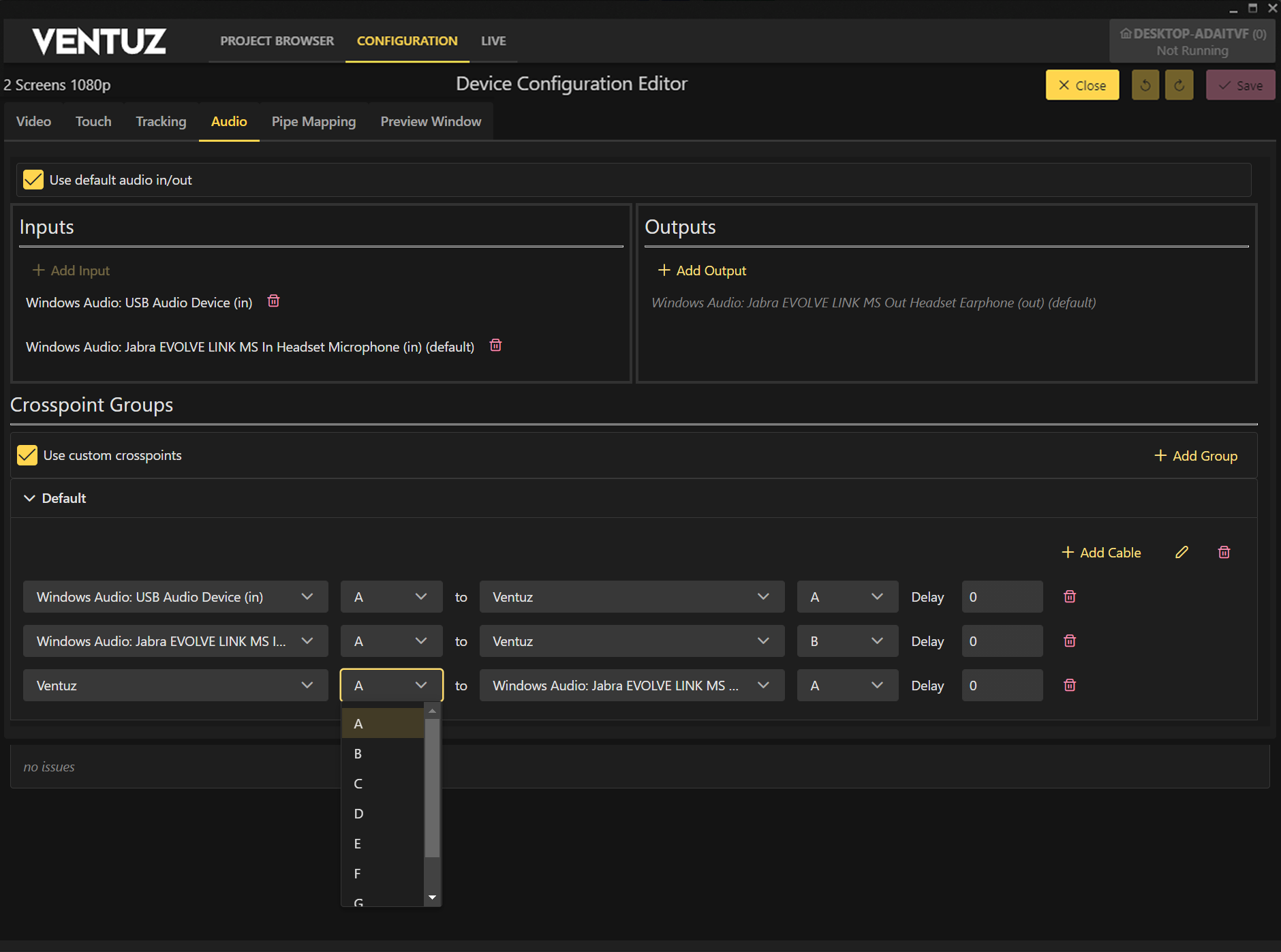
To add an Input or Output device, simply click +Add. By default, the standard Windows audio devices are used. Adding a device will override this default configuration.
The input and output channels always work as a stereo pair. A typical SDI device has 16 channels, and therefore 8 pairs. A sound-card configured for stereo has one stereo pair, one configured for 5.1 surround has 3 stereo pairs.
Stereo pairs are named A, B, C and so forth. Where A maps to the channels 1 and 2 (also referred as 1/2), B to 3/4, etc.
If portable devices, such as USB headsets or USB speakers, are used, Ventuz will report errors if the device is turned off or disconnected prior to the application's start-up. Additionally, some devices may alter their stream configuration based on the connected physical cabling. In such cases, Ventuz will also report a missing stream during start-up.
Ventuz Audio Interaction
To enable Ventuz to interact with audio, a virtual Ventuz device is available. This device provides 16 Record and 16 Playback stereo pairs, labeled with Ordinals from A to P.
If Ventuz needs to receive audio from a stream (e.g., for the Audio Analysis node), a cable from that stream must be connected to a Record pair of the Ventuz device. Similarly, if Ventuz outputs audio, a Playback pair must be connected to the desired output stream(s).
Audio-related nodes in Ventuz use the Record or Playback pair to route audio via the specified Ordinal. The wiring setup determines how the audio is routed.
By default, the Use Custom Crosspoints checkbox is unchecked. In this mode, Ventuz automatically connects the first stereo pair of all configured audio and video streams to the Ventuz Record Pairs and routes all available audio outputs from all audio and video streams to the Ventuz Playback Pairs. All automatic connections are grouped into a single cable group called Default.
If the Use Custom Crosspoints checkbox is checked, cables must be created manually.
The Web Browser always outputs to the default Windows Audio device. Sound played by the Web Browser is not processed through the Ventuz Video Engine and is unable to be routed to SDI or other supported devices.
ASIO devices are always displayed with 8 stereo pairs, regardless of the actual physical number of pairs. Attempting to access a non-existent pair will result in Ventuz logging an error message. This behavior is required because many ASIO drivers need exclusive access to retrieve device information.

Any input stereo pair can be mixed to any output stereo pair. In practice, only a few such cross points are typically required. Each line in the configuration represents a single cross point, which consists of an input device with a stereo pair and an output device with a stereo pair.
Cross Points (or cables) are organized into named groups. Within Ventuz, the volume and stereo panning for each group can be automated using the Volume Control Node. When automating multiple stereo pairs in parallel, grouping them and assigning a descriptive name helps maintain clarity and reduces confusion.
Ensure that only one Volume Control Node controls a group at any given time, as concurrent control may lead to unexpected behavior. The system operates on a last-in-last-out basis, meaning the last access to the group within the current frame will determine the parameters. If concurrent access occurs within a single render cycle, a silent warning message will be logged.
Each cross point has its own Delay value. While the default value is 0, this does not imply that there is no delay in the audio. The Ventuz Video Engine ensures that the minimum audio delay required to maintain synchronization with the video output is applied. The delay can be adjusted in milliseconds; however, no additional delay will be applied unless the set value exceeds the required minimum delay. The minimum delay is determined by the overall configuration of the streams and is not currently displayed to the user.
Crosspoints Example: Adding Ventuz to SDI
In the absence of a hardware keyer (internal or external) with audio mixing support, the software keyer must be utilized. This example illustrates how to pass through a 5.1 audio signal (not Dolby) from SDI input to SDI output while incorporating stereo sound effects from Ventuz.
The AV configuration for such an situation is as follows:
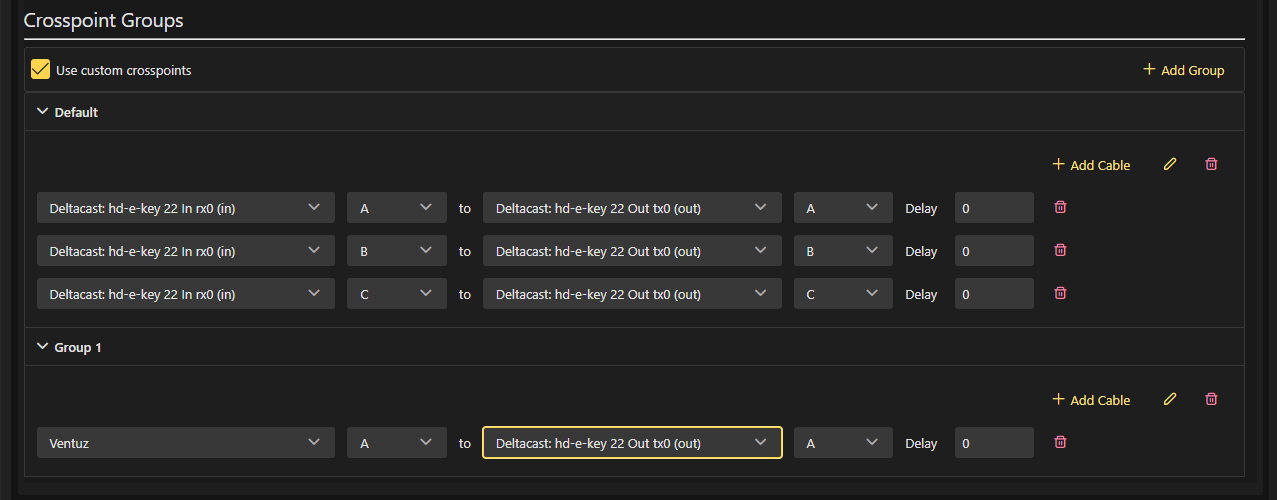
There are two groups in this configuration:
- The first group, LoopThrough, loops the SDI audio input to the SDI audio output.
- The second group, SoundEffects, adds Ventuz audio in stereo to the SDI output.
The volume of each group can be managed using the Volume Control Node. For example, the SDI loop-through volume can be reduced (ducked) before playing sound from Ventuz.
A common mistake is attempting to loop SDI output through Ventuz. This approach will not work. To better understand, consider how normal audio equipment operates: Ventuz audio output functions like a synthesizer. When incorporating a synthesizer into a mix, one does not loop the signal back through the synthesizer itself; instead, the synthesizer is connected to the mixer.
In this analogy, the SDI input is comparable to a microphone input, while the Ventuz output is akin to the output of a synthesizer. To simplify this concept, avoid thinking in terms of inputs and outputs. Instead, approach it from the perspective of a matrix mixer, where audio sources are represented on the left side of the cross-points window and audio destinations on the right. From this perspective, the Ventuz output serves as an input (source) to the mixer.
Pipe Mapping
In the Pipe Mapping section, the number of Render Pipes can be configured, and the input and output devices for each Pipe can be adjusted. For more information about Render Pipes, refer to Introduction to the Video Engine.
Since Ventuz 7, the configuration of Render Pipes is no longer tied to output streams. Previously, each configured output stream (e.g., NDI or GPU span) automatically created its own Render Pipe. Now, output streams can be created with greater flexibility, independent of the number of Render Pipes. Rendering the same Pipe multiple times with different outputs is fully supported. Additionally, the number of available Pipes is unlimited, depending on the Ventuz license.
As a result, it is necessary to configure the number of Render Pipes independently. These Pipes can then be assigned to output streams later in the Video Output stream configuration.
Click +Add Pipe to create a new Pipe. The Pipe Usage property defines the mode for the runtime within the Pipe and is set to Automatic by default. This default setting is suitable for most scenarios.
When used with the Director, the runtime Pipes will automatically adjust to the correct mode based on the Director Topology when Pipe Usage is set to Automatic.
If manual control of this property is required, it can be adjusted here. This is particularly useful when working with the Remoting API, as setting the Pipe mode manually may be necessary.
Changes such as adding or deleting Render Pipes take effect only after restarting the Runtime. However, the mapping of ordinals can be modified dynamically without requiring a restart.
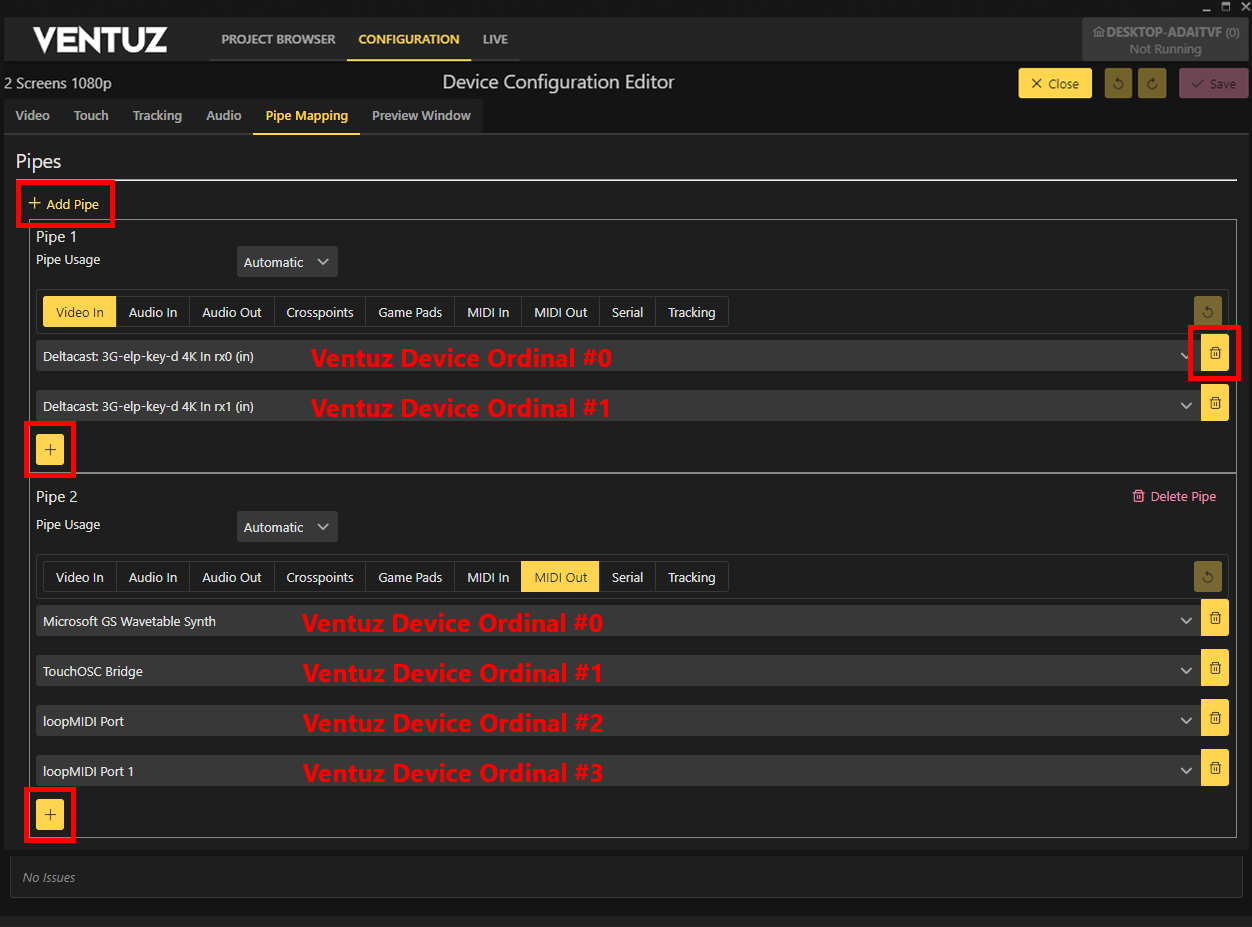
The Device Mapping tabs for each Pipe allow internal Device Ordinals to be mapped to specific inputs and outputs individually for each Pipe. The physical order of device enumeration is determined by the Device Configuration (e.g., Video Input streams) or by the Windows operating system.
These physical orders must be mapped to a logical order used by Ventuz nodes. A Ventuz node that accesses a stream or device uses a Device Ordinal, which is a zero-based index. This index is passed through the Mapping to resolve to the physical index of the available devices.
By default, a one-to-one mapping is applied, meaning logical device ordinal 0 maps to physical device index 0, ordinal 1 maps to index 1, and so on. The mapping list is continuous, ensuring that every index is mapped to another.
Each Device Mapping tab displays the available devices in selection boxes, listed in the default one-to-one order. The first selection box or row corresponds to Ordinal 0, the next to Ordinal 1, and so on. To change the mapping of a device to Ordinal 0, simply modify the selection in the first box. Multiple logical Ventuz Ordinals can be mapped to the same physical device. This configuration is independent for each created Pipe.
Using the Plus Icon, additional rows can be added to map the next higher ordinal. This makes it possible to map more Ordinals than the number of available input devices. Rows can be removed using the Bin Icon.
Logical Device Ordinals can be mapped to the following device and stream types:
Type Description Ventuz Nodes Video Input Video Input streams Live Video Audio In Ventuz Record stereo pairs Audio Analysis Audio Out Ventuz Playback stereo pairs Sound and Audio, Movie Gamepads Gamepads or Joysticks Joystick Crosspoints Audio Cross Point groups Volume Control MIDI Input MIDI input devices MIDI Input MIDI Output MIDI output devices MIDI Input Serial COM Serial COM interfaces Serial Text Tracking Tracking Device Tracking Device
The endless mapping ensures that even if, for example, no entry is visible in the 21st row, the 21st logical device ordinal will still be mapped to the 21st physical device.
Example
To configure the two Pipes so that each of them has its own live video input as its first device (Ordinal 0) use the following mapping. Please note that the second row (Ordinal 1) contains a NONE entry for both pipes, because the endless mapping maps Ordinal 1 to device 1 if no explicit entry exists for ordinal 1. In this case both pipes would resolve to device 1 (Deltacast HD key input In rx1) on Ordinal 1.
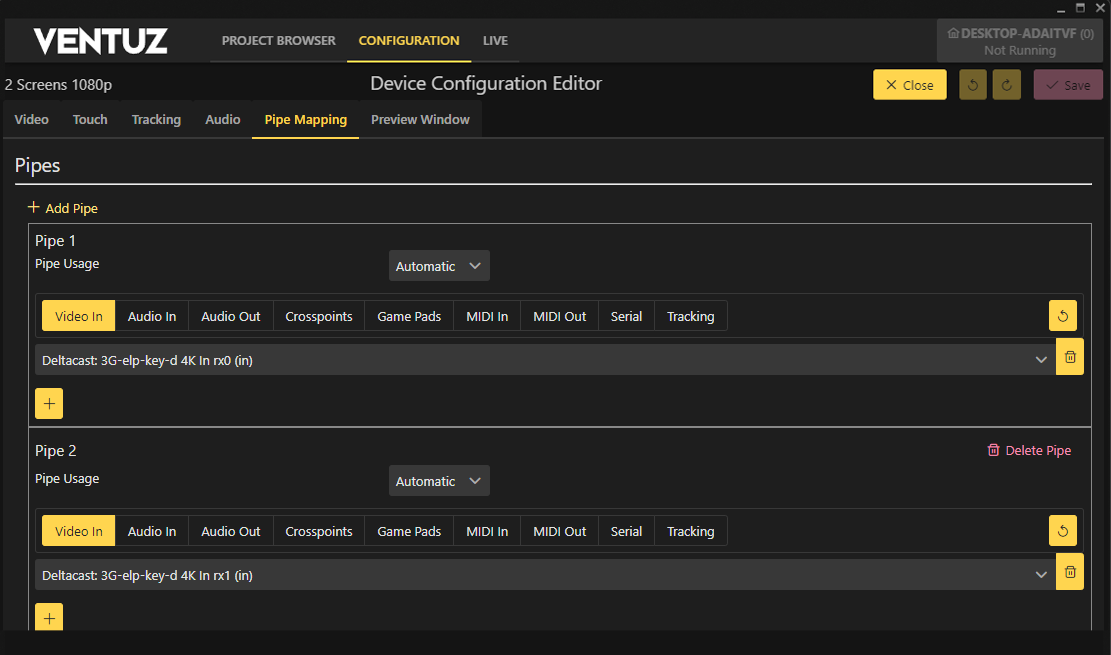
Preview Window
While rendering on any output, a Preview Window can be displayed. When Runtime is running, this window shows all output streams arranged in a mosaic layout. In a multi-GPU setup, the Preview Window displays all outputs from the GPU connected to it.
In Designer, the Preview Window functions as the familiar Renderer window, used to display the selected rendering. This feature is particularly useful when working with SDI, as it allows for easy monitoring of the rendered output.
For clarification: The Preview Window does not display the rendering of a second Preview Render Pipe. Instead, it is intended to monitor what is currently being played out.
| Enable in Designer | Enables the Preview Renderer Window in Designer. If disabled, only the configured GPU or other video outputs will render, based on the Device Configuration and Render Setup, when Physical Outputs are enabled. |
| Fullscreen Output | Select the Output the Designer should use for fullscreen. Auto: Uses a ranking system to determine which output will be used. Sorted from highest to lowest: Configured output which is not active--Configured Preview Window--Not configured Output--On HDR projects, the HDR screen is used. |
| Enable in Runtime | Auto: The Preview Window will be displayed for all non-GPU output streams. (E.g. NDI, SDI, Shared Surface) On: The Preview Window is always on. Off: The Preview Window is always off. |
| Extra Buffers | Adds extra buffer frame to the Queue of the Preview Window. |
| Synchronized | Sets the Preview Window as synchronized / async to the other outputs. Auto: If there is another output which is synchronized, the Preview Window will be set to asynchronous rendering. Note: In almost any scenario this is the best setting, since the preview rendering shouldn't influence the main output. On: The Preview window is synchronized. Off: it is always set to async rendering. |
| Render On GPU | Select the Output to render on in a Multi-GPU setup. |
